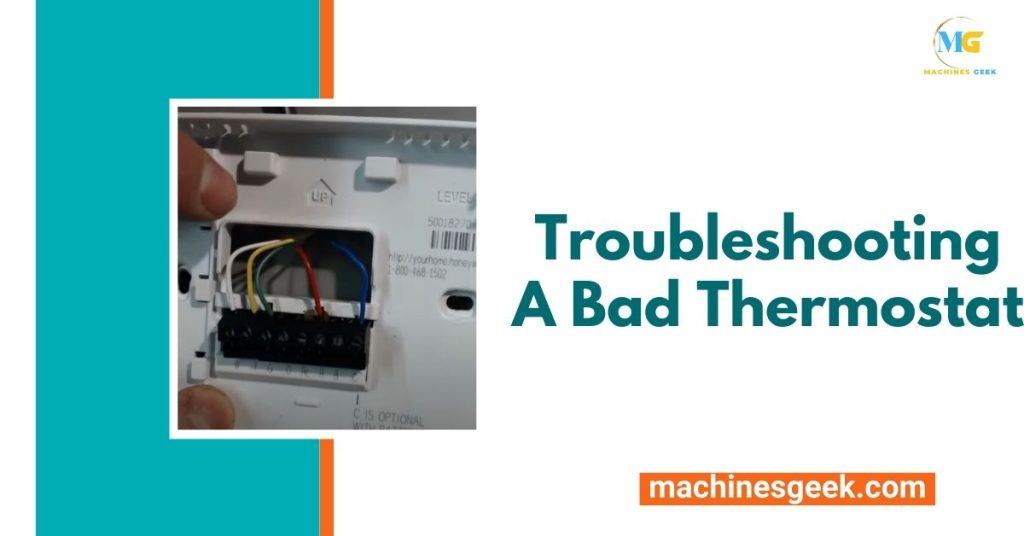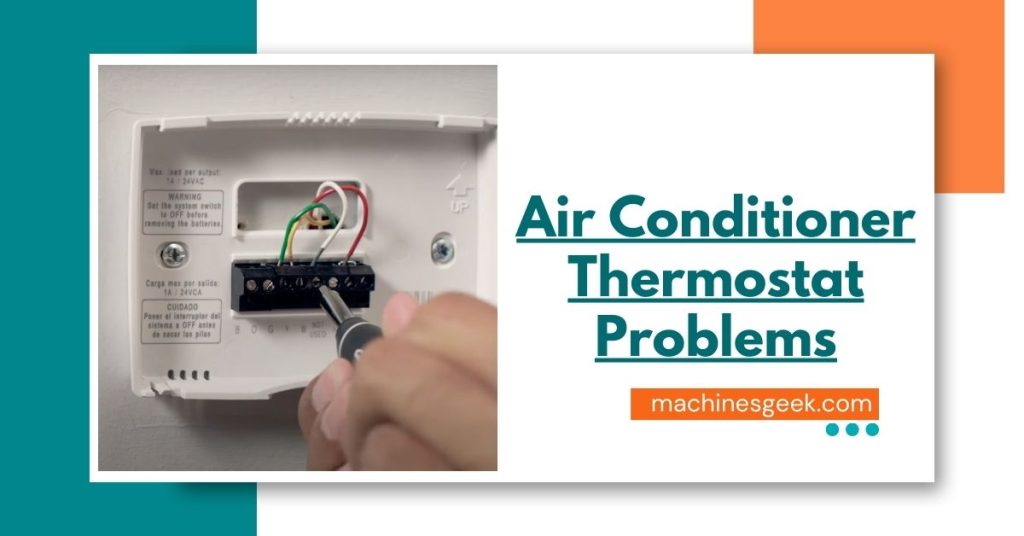Air conditioner thermostat problems can occur due to various reasons, such as faulty wiring, incorrect program settings, or a thermostat that no longer reads temperature accurately. These issues can lead to the HVAC system not turning on or off, the room temperature not matching the thermostat setting, or the programmed settings resetting themselves.
Additionally, a faulty thermostat can cause the air conditioner to work overtime and use more power than necessary. To troubleshoot these problems, you can inspect the wiring, check the thermostat program settings, clean any grime buildup, or replace the thermostat if needed.
It’s also important to ensure there is a power supply and that the wiring is intact.
Common Signs Of A Bad Thermostat
When it comes to air conditioner thermostat problems, it is important to be aware of the common signs of a bad thermostat. One indication of a faulty thermostat is when the AC or furnace won’t come on.
This can be frustrating, especially during hot or cold weather. Another sign is when the HVAC system won’t turn off, leading to energy wastage and potential damage to the system.
An unresponsive thermostat is also a red flag, as it may not be sending the proper signals to the HVAC system. Short cycling, where the system turns on and off frequently, is another common issue.
Additionally, if the room temperature doesn’t match the thermostat setting or if the programmed settings reset themselves, it may indicate a problem with the thermostat. Checking and adjusting the settings can help troubleshoot some of these issues.
Troubleshooting A Bad Thermostat

When troubleshooting a bad thermostat, there are several areas to check and adjust.
Inspecting the settings is the first step. Make sure the thermostat is set to the correct temperature and mode. If the program settings are incorrect, adjust them to match your desired preferences.
Next, inspect the wiring connections. Look for any wires that may be intermittently touching each other or the ground. If you notice any wires that are nicked or broken apart, they may need to be repaired or replaced.
In some cases, a hole in the wall, attic, or crawlspace can throw off the temperature reading on the thermostat. Check for any openings that may be affecting the accuracy of the thermostat’s readings.
If all else fails, the thermostat itself may be bad. In this case, the thermostat, control board, or other components may need to be replaced.
By troubleshooting these common thermostat problems, you can regain control over your air conditioner’s temperature and keep your home comfortable.
Cleaning And Maintenance Tips
When it comes to cleaning and maintaining an older thermostat, there are a few simple steps you can follow to ensure it functions properly. Regularly dusting inside the cover is important to prevent any dirt or debris from affecting the thermostat’s accuracy.
Removing grime build-up is also crucial, as it can interfere with the thermostat’s ability to gauge the temperature of the air in your house. By properly maintaining the thermostat, you can avoid common issues such as the temperature never reaching the desired setting. Older thermostats can be cleaned by dusting inside the cover and ensuring that there are no obstructions or damage to the wiring.
Additionally, checking the power source and replacing batteries if necessary is essential to ensure proper functionality. By taking these cleaning and maintenance precautions, you can prolong the lifespan of your thermostat and avoid any potential problems.
The Impact Of A Faulty Thermostat
A faulty thermostat can have a significant impact on your air conditioning system, leading to various issues and potential damage. One of the first problems you may experience is increased energy consumption.
When the thermostat is not functioning correctly, it may not accurately read and control the temperature, causing your HVAC system to overwork to reach the desired temperature.
This overworking can result in uneven heating or cooling throughout your home. Some areas may be too hot while others remain too cold, leading to discomfort and inefficiency.
Moreover, a faulty thermostat can potentially damage other components of your air conditioning system. It may cause your system to short-cycle, turning on and off frequently, which puts strain on the system and can lead to premature wear and tear.
To prevent these issues, it’s important to regularly inspect and troubleshoot your thermostat. Check for any wiring issues, such as wires intermittently touching each other or ground, or if a wire is nicked or broke apart. Ensure that your thermostat program settings are correct and do not throw off the temperature.
If you suspect a problem with your thermostat, it’s best to consult a professional HVAC technician to diagnose and resolve the issue.
Signs of a Bad or Broken Thermostat:
- The AC or Furnace Won’t Come On
- The HVAC System Won’t Turn Off
- The Thermostat Is Unresponsive
- The HVAC System Short-Cycles
- The Room Temperature Doesn’t Match the Thermostat Setting
- The Programmed Settings Reset Themselves
- Check and Adjust the Settings
It’s crucial to address thermostat problems promptly to ensure optimal comfort, energy efficiency, and longevity of your air conditioning system.
Troubleshooting Tips For Specific Thermostat Types
Window-Thermostat Compatibility Issues: When it comes to window air conditioners, compatibility between the unit and the thermostat can be a problem. It’s important to make sure that the thermostat you’re using is compatible with your window AC unit.
Carrier Thermostat Troubleshooting: If your Carrier thermostat is not functioning correctly, it could be due to several issues. Check the wiring, and program settings, and ensure there are no damaged components.
Nest Thermostat Functionality Problems: Common problems with Nest thermostats include unresponsiveness, short cycling, and incorrect temperature readings. Make sure to check and adjust the thermostat settings if needed.
Smart Thermostat Compatibility Issues: Smart thermostats offer advanced features but may not be compatible with all HVAC systems. It’s important to check the compatibility of your HVAC system with the smart thermostat before installation.
In-Car Air Conditioner Thermostat Issues: When the thermostat in your car’s air conditioner goes bad, it can result in the HVAC system using more power than necessary. This can lead to inefficient cooling and increased energy consumption.
Frequently Asked Questions
How Do I Know If My AC Thermostat Is Bad?
If your AC thermostat is bad, there are a few signs to look for: the AC or furnace won’t come on, the HVAC system won’t turn off, the thermostat is unresponsive, the HVAC system short-cycles, and the room temperature doesn’t match the thermostat setting.
Check and adjust the settings, and if the issue persists, it may be time to replace your thermostat.
What Is A Common Problem With Thermostat?
A common problem with a thermostat is that it may not accurately gauge the temperature, resulting in the temperature never reaching the desired setting. This can happen due to grime buildup inside the thermostat. Older thermostats can be cleaned by dusting inside the cover.
Additionally, a faulty thermostat can cause the HVAC system to work overtime and use more power than necessary. It may also cause the AC not to respond or short cycle. Checking for power issues or bad wiring is recommended.
What Happens When Air Conditioner Thermostat Goes Bad?
When an air conditioner thermostat goes bad, it can cause inaccurate temperature readings and make the HVAC system work harder. This leads to increased energy consumption and potential system malfunctions.
Can Resetting the Air Conditioner Thermostat Fix Common Problems?
If your air conditioner is not functioning properly, a quick fix could be to reset the air conditioner thermostat. Many common problems such as inaccurate temperature readings or erratic behavior can be resolved by simply performing a reset air conditioner thermostat. It’s a simple step that can often solve frustrating issues.
Conclusion
To troubleshoot air conditioner thermostat problems, it is important to identify common issues such as faulty wiring, incorrect programming, or a thermostat that no longer reads temperature accurately. These problems can cause your HVAC system to work overtime, leading to increased energy consumption.
If you notice that your AC or furnace won’t come on, the thermostat is unresponsive, or the room temperature doesn’t match the setting, it may be time to inspect and adjust the thermostat settings or clean the thermostat if necessary.
In some cases, a faulty thermostat may need to be replaced for optimal performance. Remember to check the circuit breaker box and replace the batteries before assuming there is a larger problem. By addressing thermostat problems promptly, you can ensure that your air conditioner functions properly and efficiently.








